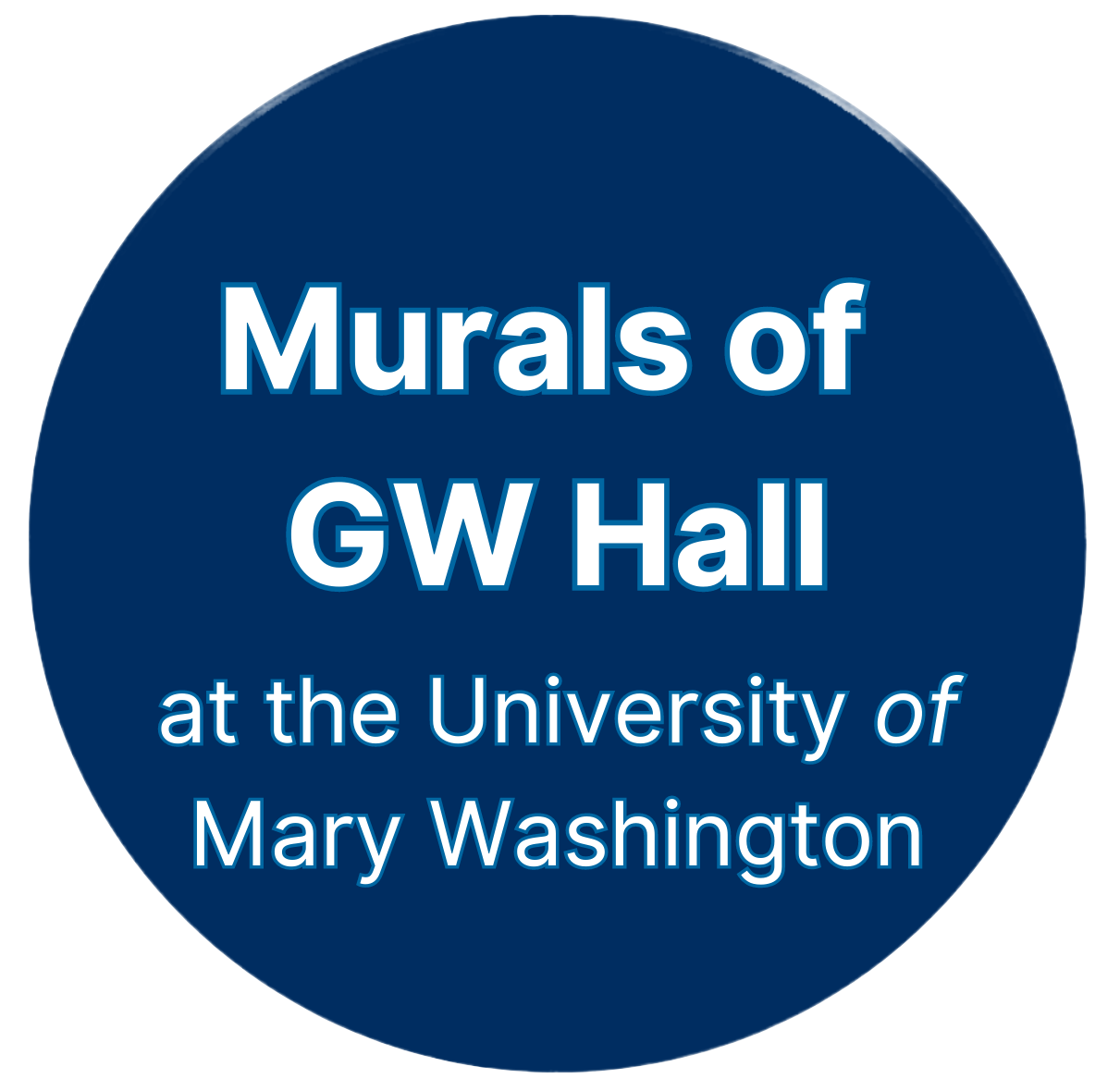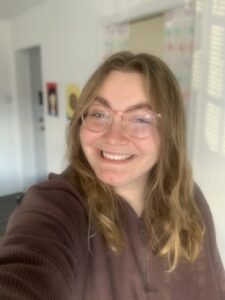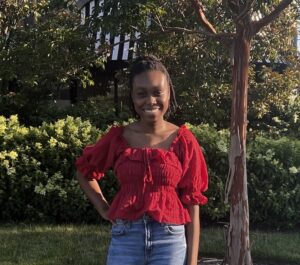Camera Work: Taylor Coleman; Editing and Narration: Bryan Rivas.
The third panel developed for George Washington Hall featured various facets of student life and self-expression, including the arts and modern dance. Student performances were often held in George Washington Hall auditorium, where Schnellock drew on his previous experience as a commercial artist to develop playbills and other promotional materials featuring student performers.[1] The ticket window for these events was once located in the opening on the left side of this panel where contextual information about the murals is provided.

Meritorious Service Certificate presented to him at a ceremony held in honor of his retirement in 1956.
As senior mechanic and janitor foreman, Wallace Alsop kept George Washington Hall open and illuminated for evening events and performances. Dean Edward Alvey, Jr., recalled, “On special occasions Wallace [Alsop] donned a resplendent uniform, stood just about where his portrait is now, and bowed to distinguished guests as they entered.” Alvey recalled that Alsop “was proud of the uniform and wore it with an air of authority.” The Dean characterized Alsop as “a man of inherent dignity. He was extremely polite but never servile… His tone was always respectful and at the same time carried the calm assurance of authority. One of Wallace’s interesting habits was the way he would say ‘Thank you, sir,’ or ‘Thank you, ma’am’ whenever one greeted him with ‘Good morning, Wallace.’”[3]
Alvey’s testimony was intended to be a tribute to Alsop—who worked at the college for thirty-five years (1922-1956). But his recollections suggest that members of the Mary Washington community routinely referred to Alsop by his first name, denying him the title Mr. while expecting him to respond with honorific forms of address. This expected pattern of deference is a troubling legacy of Jim Crow racial etiquette, in keeping with the practice of only hiring white faculty and admitting white students to Mary Washington.
The first Black student was admitted to Mary Washington College in 1962, and later the University of Virginia Board of Visitors formally adopted a desegregation policy in 1964. As the student body became more diverse, Alsop’s great-granddaughter Bonnie G. Skinner ’85 enrolled at Mary Washington. “I was always amazed at how lifelike my great-grandfather looked in that painting,” she wrote. Skinner recalled that his enduring presence in the mural served as a “source of inspiration for me.”[4]
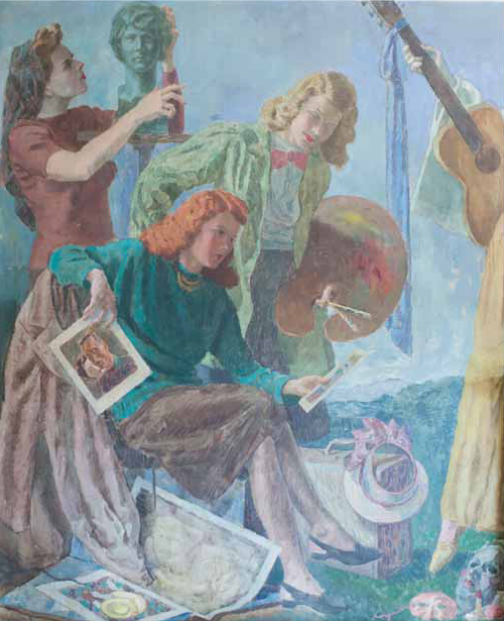

On the other side of the ticket window, a group of students represents the Art Department. Similar scenes featuring the MWC Art Club were incorporated into the Battlefield yearbook and may have inspired Schnellock’s rendering of this group.[6]
Gene Jones Pierson ’49 has been identified as the seated figure. She is holding a self-portrait of Julien Binford, professor of art from 1946 to 1971 and a colleague of Emil Schnellock.[7]

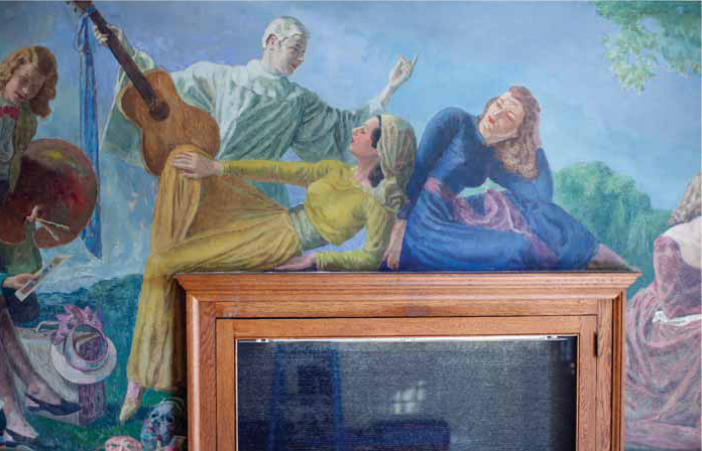

Above the signage box is a trio of figures representing the Senior Modern Dance Club. The image may have been inspired by a photograph of a similar trio published in the 1943 Battlefield. Captioned “Action, Form, and Grace,” the pictured students were Anne Harris, Lillias Scott, and Myran Russell.[9] The three students were featured dancers during the 1943 May Day pageant La Zingara set in the Royal Gardens of seventeenth-century Madrid.[10] Lilias Scott Keel ’44 and Ann Harris Skinner 44’ were the original models for the dancers in the yellow and blue dresses respectively. Campus histories have tentatively identified the figure holding the guitar as Margaret “Peggy” Moran Logan ’44, but the inspiration may also have been Myran Russell.[11]

McDowell from the
’51 edition of the Battlefield
However, like other figures in the murals, Schnellock worked with another student—Elsie Scott McDowell ‘51– to refine his presentation of the dancers. McDowell recalled that Schnellock recruited her while she was enrolled in his Art Appreciation Class. “After class one day, Mr. Schnellock asked if I would help him out with the mural,” she wrote. “It seems that another ‘town girl,’ Lilias Scott, had started to pose for the figure—leaning back, in a dance costume…Only an outline had been sketched. Lilias could no longer assist him with the project. Maybe she had graduated because she was older that I. Because I was very fond of Mr. Schnellock’s class, I volunteered to help with the figure.” McDowell recalled that she posed leaning back for many days, and also sat as a model for the figure in the blue dress. McDowell remembered, “My dress—light blue velvet—was made just for this picture by my mother.” McDowell noted that sitting for extended periods of time for the project taught her patience, but also stated that Schnellock’s art appreciation class taught her “to love color, nature, line, and to appreciate the ‘masters.’”[12]
Taylor Coleman; Editing and Narration: Taylor Coleman.
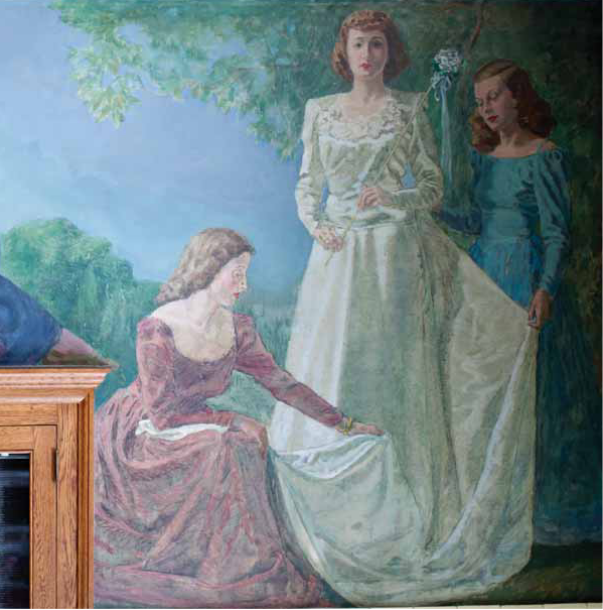
To the right of the panel is a representation of Mary Washington’s May Queen tradition (1914-1968). As early as February, graduating classes prepared a list of nominees for May Queen and the campus gathered in the auditorium of George Washington Hall to select the queen and her court. Dean Edward Alvey recalled that “nominees promenaded in evening dress to appropriate music, while the audience took note of their poise, bearing, beauty, and ‘queenly presence.’” Ballots were cast and counted at the assembly.[14] The May Queen and her court were celebrated in student publications, and were featured regularly in the Battlefield yearbook. May Day celebrations and the selection of a queen and her court are no longer a part of the Mary Washington calendar. As William Crawley notes in his centennial history, “the event came into disfavor in the late 1960s, the victim of changing cultural ideals that made the celebration seem increasingly anachronistic, a frivolous exercise based on superficial—or, worse, sexist—attitudes.” The event was discontinued after 1968.[15]
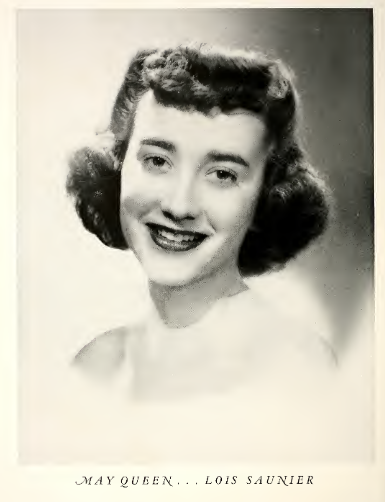
from the 1948 Battlefield

In the representation of the May Queen tradition included in the mural, the central standing figure is Lois Saunier Hornsby ’48, the May Queen of 1948 who also served as president of the senior class. The kneeling figure adjusting Hornsby’s dress is Mary Will Sheffield ’48, a member of the 1948 May Court. Standing in blue is Dean Alvey’s daughter Ellen Alvey Montllor ’48, who was a member of the court in 1945.[16]
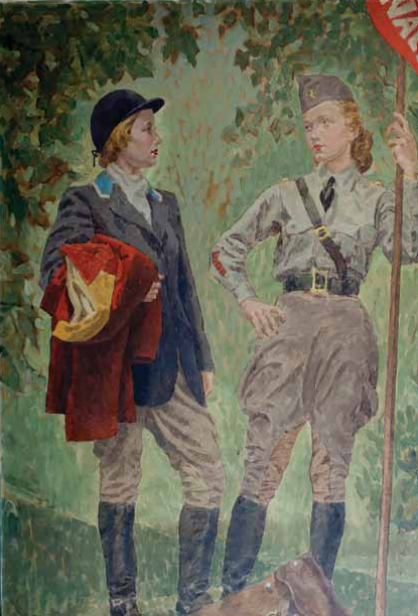
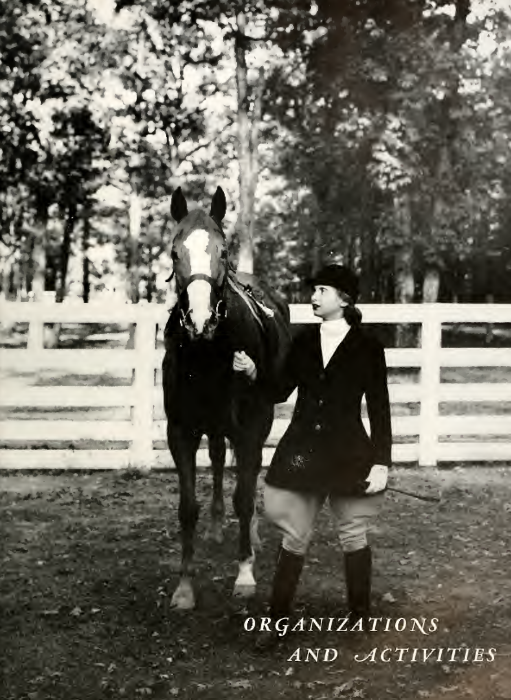
Flanking the main door are the last two murals completed for George Washington Hall. To the left are two figures in riding clothes. Phyllis Nash ‘54 is presented in blue competition dress as a member of the equestrienne Hoofprints Club.[18] The 1948 Battlefield depicts a member of the club in similar attire.
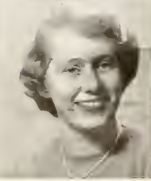
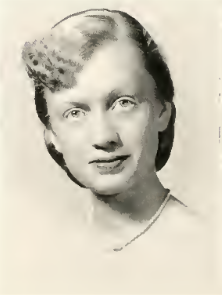
Dorothy “Dot” Reisig ’53 is pictured in the uniform and carrying the pennant of the Calvary Troop. The 1948 Battlefield depicts a member of the club in similar attire.
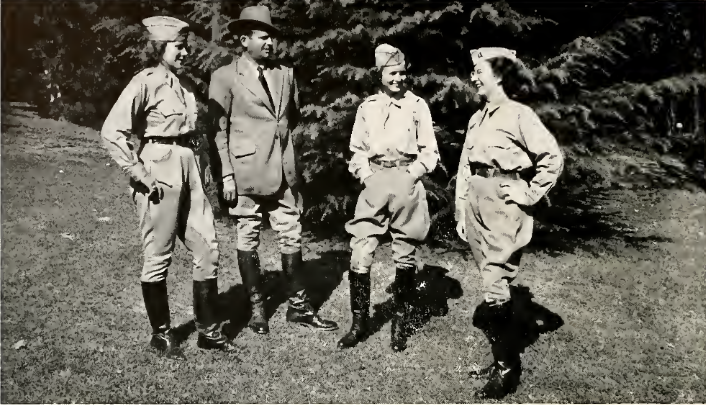
The MWC Calvary formed at the outset of World War II when President Combs called on student organizations—like the Hoofprints Club –to indicate how they might contribute to national defense. The troop drilled in khaki uniforms under the direction of their faculty advisor and the local Virginia Protective Force. The Calvary Troop was organized to contribute to the civil defense in wartime, but after the war, the troop redefined itself as a service organization and continued to be a prominent presence on campus until 1958.[20]
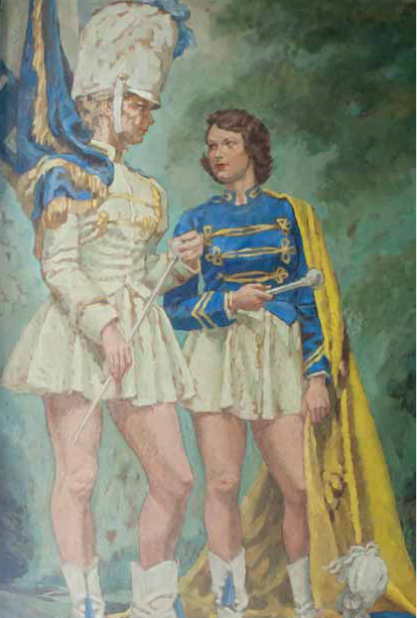

To the right of the door are two figures representing Mary Washington College’s Marching Band. Dawn Van Buskirk ’53 stands to the right representing a majorette. Drum major Doris Ann Lindsey Whitfield ’53 stands in white with a plumed hat on her head.[22] The drum major’s father Almont Lindsey taught history at the college for thirty-eight years. Whitfield recalled that the muralist based this image on photographs and that her father was “a friend of Mr. Schnellock.”[23]
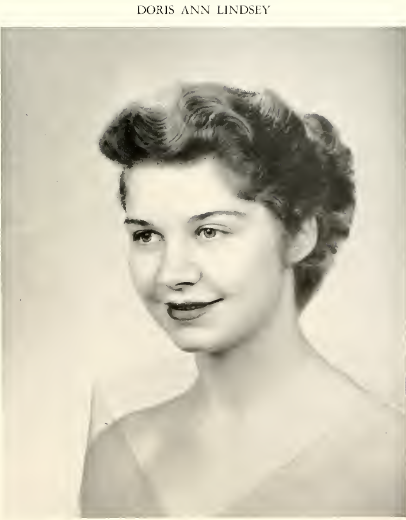
The band performed during halftime programs at college football games in the area, and marched at events like the Apple Blossom Festival in Winchester and the Tobacco Festival in Richmond. The presentation of an “all-girl” marching band was a novelty in the region. Dean Edward Alvey recalled that the band’s “first appearance in uniform created a sensation as they marched through campus.”
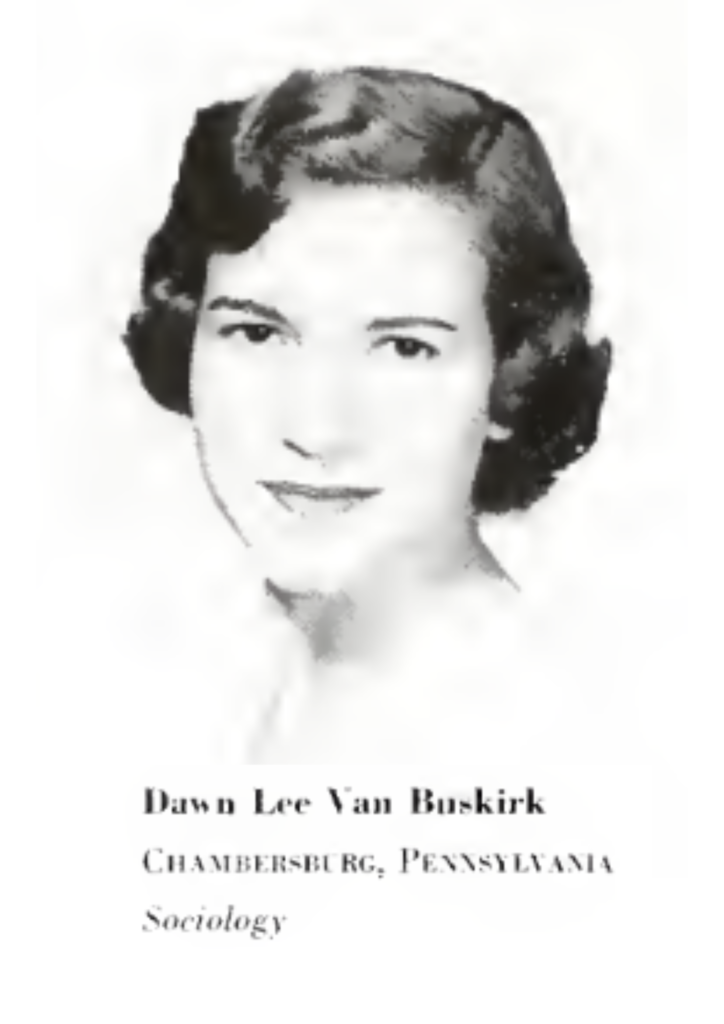
At an institution which prohibited students from wearing shorts on or off campus, the “short white skirts and blue jackets, with white boots and helmet-type headdress… made a colorful appearance.” At least one female member of the faculty complained about the shortness of the skirts, but her concerns were dismissed.[24] Jo Jane Williams Van Hook ’55 recalled being paid by the College to serve as the “legs” model for the representation of Van Buskirk as Schnellock completed this panel.[25]
Mary Washington College’s Marching Band was led by Ronald Faulkner who stands supervising two other music students in the panel immediately adjacent. The completion of these two panels was separated by more than a decade. The placement of this representation of the Marching Band in the same corner brought Schnellock and the mural painting project “full circle” and no further additions were made to the murals in George Washington Hall.
There is evidence that Schnellock experimented with and considered other representations of life on campus, particularly athletics. Susan Fuss Hill ’45 recalled posing for two different figures of a swimmer and tennis player.[26] Similarly, Anne Elley Everette Mish ’47 vividly remembered posing “for days holding a tennis racket in a swing position.”[27]
These representations that were never formally included in the mural remind us that although the panels in George Washington Hall provide us a glimpse into student life in the 1940s and 1950s, they do not capture it in its totality. Moreover, as these panels illustrate, the student body, academic life, and activities on campus are constantly in evolution. The Calvary Troop that Schnellock painted in the early 1950s did not exist when he began his project in the early 1940s. As the University of Mary Washington works to make its campus environment more inclusive, it is appropriate for representations of campus life to expand and change alongside our campus community.
[1] Bette Caum Royal, response to Schnellock Project survey, Chadis Collection, UMW Special Collections and University Archives, Fredericksburg, VA.
[2] Image Credit: Karen Pearlman of K. Pearlman Photography, 2015. Teresa Boegler and Karen Pearlman, “The Murals of the University of Mary Washington: Emil Schnellock in Collaboration with Faculty and Students,” Center for Historic Preservation, University of Mary Washington, p. 12.
[3] Edward Alvey, Jr., History of Mary Washington College: 1908-1972 (Charlottesville: University Press of Virginia, 1974), 109-110. For more information about Wallace Alsop, see Michael Spencer, Department of Historic Preservation, “William Wallace Alsop (1881-1968),” http://cas.umw.edu/hisp/files/2020/02/William-Wallace-Alsop.pdf.
[4] Bonnie G. Skinner to Paulette Watson, 23 February 1990, Chadis Collection, UMW Special Collections and University Archives, Fredericksburg, VA.
[5] Image Credit: Karen Pearlman of K. Pearlman Photography, 2015. Teresa Boegler and Karen Pearlman, “The Murals of the University of Mary Washington: Emil Schnellock in Collaboration with Faculty and Students,” Center for Historic Preservation, University of Mary Washington, p. 13.
[6] Art Club as depicted in 1944 Battlefield, MWC student yearbook.
[7] Edward Alvey, Jr., “The Murals in George Washington Hall,” Mary Washington Today (1990): 5.
[8] Image Credit: Karen Pearlman of K. Pearlman Photography, 2015. Teresa Boegler and Karen Pearlman, “The Murals of the University of Mary Washington: Emil Schnellock in Collaboration with Faculty and Students,” Center for Historic Preservation, University of Mary Washington, p. 14.
[9] Senior Modern Dance Club as depicted in 1943 Battlefield; students identified in photo illustrations in Edward Alvey, Jr., History of Mary Washington College: 1908-1972 (Charlottesville: University Press of Virginia, 1974).
[10] Edward Alvey, Jr., History of Mary Washington College: 1908-1972 (Charlottesville: University Press of Virginia, 1974), 249.
[11] Edward Alvey, Jr., “The Murals in George Washington Hall,” Mary Washington Today (1990): 4-5.
[12] Elsie Scott McDowell, response to Schnellock Project survey, Chadis Collection, UMW Special Collections and University Archives, Fredericksburg, VA.
[13] Image Credit: Karen Pearlman of K. Pearlman Photography, 2015. Teresa Boegler and Karen Pearlman, “The Murals of the University of Mary Washington: Emil Schnellock in Collaboration with Faculty and Students,” Center for Historic Preservation, University of Mary Washington, p. 15.
[14] Edward Alvey, Jr., History of Mary Washington College: 1908-1972 (Charlottesville: University Press of Virginia, 1974), 246.
[15] William B. Crawley, Jr., University of Mary Washington: A Centennial History, 1908-2008 (Fredericksburg, VA: University of Mary Washington Foundation, 2008), 16.
[16] Edward Alvey, Jr., “The Murals in George Washington Hall,” Mary Washington Today (1990): 4.
[17]Image Credit: Karen Pearlman of K. Pearlman Photography, 2015. Teresa Boegler and Karen Pearlman, “The Murals of the University of Mary Washington: Emil Schnellock in Collaboration with Faculty and Students,” Center for Historic Preservation, University of Mary Washington, p. 16.
[18] Edward Alvey, Jr., “The Murals in George Washington Hall,” Mary Washington Today (1990): 3.
[19] Edward Alvey, Jr., “The Murals in George Washington Hall,” Mary Washington Today (1990): 3.
[20] William B. Crawley, Jr., University of Mary Washington: A Centennial History, 1908-2008 (Fredericksburg, VA: University of Mary Washington Foundation, 2008), 47-49.
[21]Image Credit: Karen Pearlman of K. Pearlman Photography, 2015. Teresa Boegler and Karen Pearlman, “The Murals of the University of Mary Washington: Emil Schnellock in Collaboration with Faculty and Students,” Center for Historic Preservation, University of Mary Washington, p. 17.
[22] Edward Alvey, Jr., “The Murals in George Washington Hall,” Mary Washington Today (1990): 3.
[23] Doris Ann Lindsey Whitfield, response to Schnelllock Project survey, Chadis Collection, UMW Special Collections and University Archives, Fredericksburg, VA.
[24] Edward Alvey, Jr., History of Mary Washington College: 1908-1972 (Charlottesville: University Press of Virginia, 1974), 205-206; William B. Crawley, Jr., University of Mary Washington: A Centennial History, 1908-2008 (Fredericksburg, VA: University of Mary Washington Foundation, 2008), 35-36.
[25] Jo Jane Williams Van Hook, response to Schnellock Project survey, Chadis Collection, UMW Special Collections and University Archives, Fredericksburg, VA.
[26] Susan Fuss Hill, response to Schnellock Project survey, Chadis Collection, UMW Special Collections and University Archives, Fredericksburg, VA.
[27] Anne Elley Everette Mish, response to Schnellock Project survey, Chadis Collection, UMW Special Collections and University Archives, Fredericksburg, VA.
